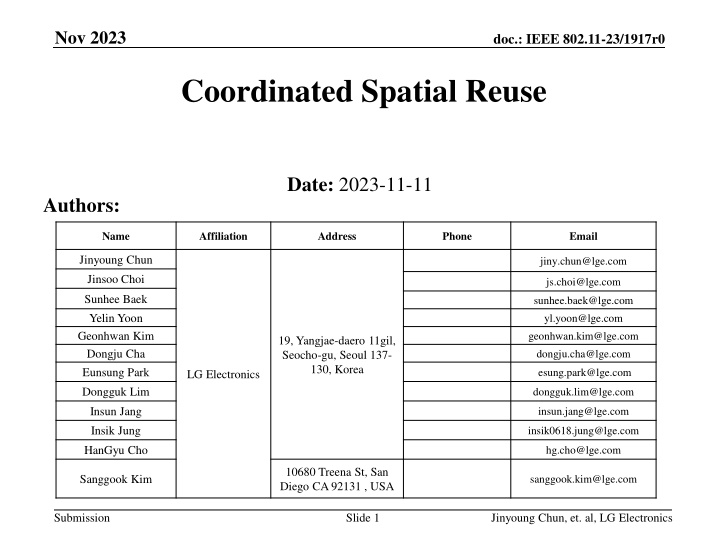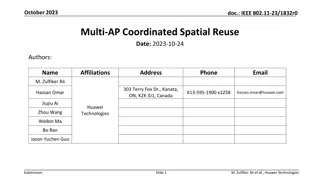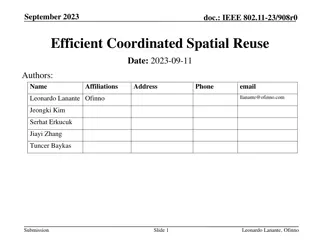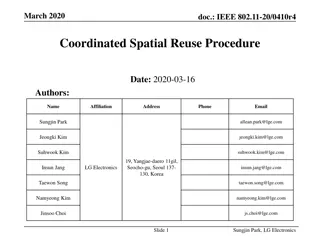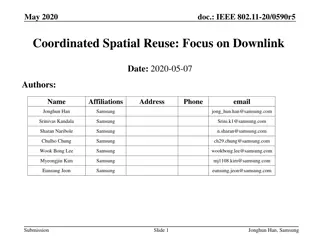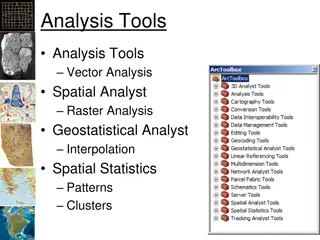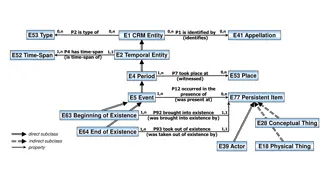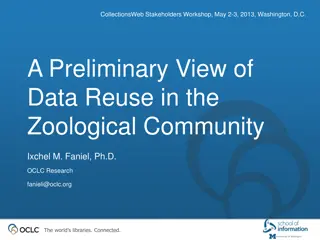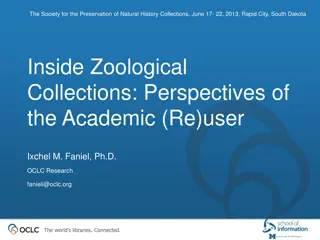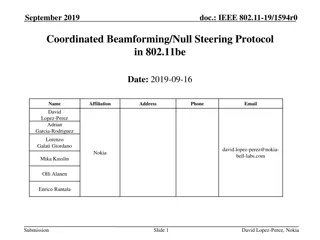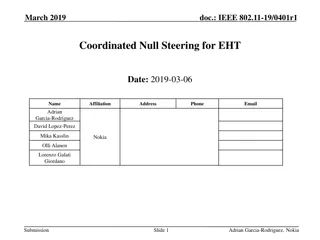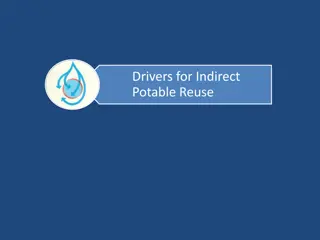Coordinated Spatial Reuse
Explore the concept of Coordinated Spatial Reuse (C-SR) in IEEE 802.11 networks, a scheme where multiple access points (APs) transmit data simultaneously to reduce interference and enhance resource utilization. Learn about the definition, benefits, and necessary components for successful C-SR operation.
Uploaded on Mar 07, 2024 | 4 Views
Download Presentation

Please find below an Image/Link to download the presentation.
The content on the website is provided AS IS for your information and personal use only. It may not be sold, licensed, or shared on other websites without obtaining consent from the author.If you encounter any issues during the download, it is possible that the publisher has removed the file from their server.
You are allowed to download the files provided on this website for personal or commercial use, subject to the condition that they are used lawfully. All files are the property of their respective owners.
The content on the website is provided AS IS for your information and personal use only. It may not be sold, licensed, or shared on other websites without obtaining consent from the author.
E N D
Presentation Transcript
Nov 2023 doc.: IEEE 802.11-23/1917r0 Coordinated Spatial Reuse Date: 2023-11-11 Authors: Name Affiliation Address Phone Email Jinyoung Chun Jinsoo Choi jiny.chun@lge.com js.choi@lge.com Sunhee Baek Yelin Yoon Geonhwan Kim Dongju Cha Eunsung Park Dongguk Lim Insun Jang Insik Jung HanGyu Cho sunhee.baek@lge.com yl.yoon@lge.com geonhwan.kim@lge.com dongju.cha@lge.com 19, Yangjae-daero 11gil, Seocho-gu, Seoul 137- 130, Korea esung.park@lge.com LG Electronics dongguk.lim@lge.com insun.jang@lge.com insik0618.jung@lge.com hg.cho@lge.com 10680 Treena St, San Diego CA 92131 , USA Sanggook Kim sanggook.kim@lge.com Submission Slide 1 Jinyoung Chun, et. al, LG Electronics
Nov 2023 doc.: IEEE 802.11-23/1917r0 Introduction From 11be, there was a lot of discussions about the Multi-AP scheme, in which APs transmit data jointly or coordinately. Recently, C-SR (Coordinated Spatial Reuse) scheme has been discussed a lot. That s because C-SR has gain over single operation and can operate more simply than other schemes. Here, we ll review the definition and benefit of C-SR, and find out what is necessary for C-SR operation. Submission Slide 2 Jinyoung Chun, et. al, LG Electronics
Nov 2023 doc.: IEEE 802.11-23/1917r0 [Recap] The Definition What is C-SR Two or more APs transmit simultaneously during the same TXOP. Sharing AP[NOTE]coordinates with other Shared APs[NOTE]to reduce interference and use resources efficiently. One of BSS AP and OBSS AP can be a Sharing AP in the below example. [NOTE] The definition is in 11be SFD [1]. - An EHT AP which obtains TXOP and initiates the Multi-AP coordination is the Sharing AP. - An EHT AP which is coordinated for the Multi-AP transmission by the Sharing AP is the Shared AP. Submission Slide 3 Jinyoung Chun, et. al, LG Electronics
Nov 2023 doc.: IEEE 802.11-23/1917r0 [Recap] Benefit of C-SR The performance and the gain C-SR outperform TDMA especially low interference region in spite of practical implementation that includes fairness constraint and CSI inaccuracy protection [2]. C-SR can improve sum Throughput, and may require accurate fast rate adaptation and interference control [3]. Co-SR can achieve higher throughput gain than Time/Freq Scheduling and Co-OFDMA. And can be implemented easier than Co-BF and Joint Tx [4]. From that, it s beneficial to define C-SR in 11bn. The discussion point is to find out what is necessary for C-SR operation as below. The method of interference measurement The method of shared AP setup The method of transmission Submission Slide 4 Jinyoung Chun, et. al, LG Electronics
Nov 2023 doc.: IEEE 802.11-23/1917r0 Interference measurement (1/2) Sharing AP needs to know the exact interference level from OBSS to control own Tx Power as well as shared AP s Tx Power. (Others like MCS are TBD.) And many contributions suggest the method of interference measurement [5-7]. For DL C-SR, the AP needs to know the interference level from OBSS AP s DL or OBSS STA s UL to BSS STA(s). So the BSS STA(s) can report the interference level to the AP by measuring OBSS AP s signal like beacon or NDP OBSS STA s signal like BA frame It may be difficult for BSS STA to catch the timing of BA frame of many OBSS STAs. (FFS) Submission Slide 5 Jinyoung Chun, et. al, LG Electronics
Nov 2023 doc.: IEEE 802.11-23/1917r0 Interference measurement (2/2) UL C-SR may be operated with AP s control like Trigger frame. For the operation, AP needs to know the interference level from OBSS AP s DL or OBSS STA s UL to itself by measuring OBSS AP s signal like beacon or NDP OBSS STA s signal like BA frame (FFS) Especially, the interference measurement per sub-channel* needs for not only for C-SR operation but also for the operation with Non-primary channel access, etc [5]. * The unit of sub-channel is TBD. See the Appendix. Submission Slide 6 Jinyoung Chun, et. al, LG Electronics
Nov 2023 doc.: IEEE 802.11-23/1917r0 Shared AP setup Sharing AP can set shared APs to operate C-SR together in its TXOP. Sharing AP transmits the invitation message to OBSS APs based on Interference level, etc [NOTE]. Sharing AP may get more information from OBSS APs such as buffer status, capability, etc before the TXOP. OBSS APs respond whether participate or not with some information like Tx power. Or some can t respond. Sharing AP transmits the confirmation message to shared AP(s). It has C-SR information such as recommended Tx Power, MCS, etc. Another detail channel measurement between Sharing AP and Shared AP(s) may be needed for C-SR operation. [NOTE] The OBSS APs can be pre-selected APs by AP configuration setup procedure.[8] Submission Slide 7 Jinyoung Chun, et. al, LG Electronics
Nov 2023 doc.: IEEE 802.11-23/1917r0 C-SR Transmission Sharing/Shared AP transmit DL C-SR PPDU or Trigger frame for UL C-SR PPDU. Sharing AP transmits DL PPDU with Tx Power control or Trigger frame with recommended Tx Power for UL TB PPDU. STA can respond BA frame or UL PPDU with Tx Power control. In BA frame, it s TBD whether SR is allowed or not. Shared AP also can transmit DL PPDU or Trigger frame by s guideline. The sync with is TBD. STA can respond BA frame or UL PPDU with Tx Power Control like . The allowance of response or sync, etc are TBD. Submission Slide 8 Jinyoung Chun, et. al, LG Electronics
Nov 2023 doc.: IEEE 802.11-23/1917r0 Summary It suggest that C-SR is supported in 11bn because it has gain than single operation and also can be operated simply than other schemes. To support C-SR, we need to define the methods as below in 11bn. The method of Interference measurement The method of shared AP setup The method of C-SR transmission Submission Slide 9 Jinyoung Chun, et. al, LG Electronics
Nov 2023 doc.: IEEE 802.11-23/1917r0 Reference [1] IEEE 802.11-20/1935r66, Compendium of straw polls and potential changes to the Specification Framework Document Part 2 [2] IEEE 802.11-23/1023r2, Coordinated Spatial Reuse in a 4 AP Topology [3] IEEE 802.11-23/1037r0, Performance of Coordinated Spatial Reuse [4] IEEE 802.11-23/1822r0, Recap on Coordinated Spatial Reuse Operation [5] IEEE 802.11-23/854r0, Obtaining OBSS channel Information for Multi- AP operation [6] IEEE 802.11-23/668r2, Coordinated Measurement [7] IEEE 802.11-23/908r0, Efficient Coordinated Spatial Reuse [8] IEEE 802.11-23/1912r0, Coordinated TDMA Procedure Submission Slide 10 Jinyoung Chun, et. al, LG Electronics
Nov 2023 doc.: IEEE 802.11-23/1917r0 Appendix: Recap of [5] An HE AP participating in spatial reuse may request an associated non-AP HE STA to gather information regarding the neighborhood by sending a Beacon request. But current radio channel measurement through beacon request/report is the long-term and the delayed report. So interference measurement like NDP sounding may be needed for Multi-AP operation. Sharing AP can select and schedule the frequency resource to shared APs based on the channel status information. For example, the channel information between OBSS AP and BSS STAs helps Sharing AP operates C-SR or C-BF by scheduling to avoid the interference. Submission Slide 11 Jinyoung Chun, et. al, LG Electronics
Nov 2023 doc.: IEEE 802.11-23/1917r0 Straw Poll 1 Do you agree to add the following text to the TGbn SFD: - An UHR AP which obtains TXOP and initiates the Multi-AP coordination is the Sharing AP[NOTE]. - An UHR AP which is coordinated for the Multi-AP transmission by the Sharing AP is the Shared AP[NOTE]. [NOTE] The names can be modified. * it s from 11be SFD. Submission Slide 12 Jinyoung Chun, et. al, LG Electronics
Nov 2023 doc.: IEEE 802.11-23/1917r0 Straw Poll 2 Do you agree to add the following text to the TGbn SFD: TGbn supports Coordinated Spatial Reuse (C-SR), which is - The transmission of a PPDU on the medium under certain conditions and some coordination when a PPDU has been detected that would otherwise have prevented the transmission. - The coordination is from Sharing AP to Shared APs. The details are TBD. * It refers to the definition of SR in 11be draft: spatial reuse: [SR] The transmission of a physical layer (PHY) protocol data unit (PPDU) on the medium under certain conditions when a PPDU has been detected that would otherwise have prevented the transmission. Submission Slide 13 Jinyoung Chun, et. al, LG Electronics
Nov 2023 doc.: IEEE 802.11-23/1917r0 Straw Poll 3 Do you agree to add the following text to the TGbn SFD: TGbn supports to define the method of interference measurement between an AP and STA(s) associated with neighboring AP(s). - The detail method is TBD - The frequency granularity of the interference measurement is TBD. Submission Slide 14 Jinyoung Chun, et. al, LG Electronics
Nov 2023 doc.: IEEE 802.11-23/1917r0 Straw Poll 4 Do you agree to add the following text to the TGbn SFD: TGbn supports to define the method to select shared APs for C-SR in a TXOP. - The detail method is TBD. Submission Slide 15 Jinyoung Chun, et. al, LG Electronics
